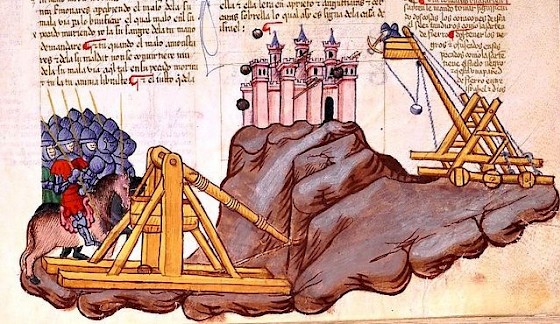How to Besiege a Castle
In medieval warfare one of the most essential skills a military commander could acquire was how to besiege a castle. Throughout much of medieval Europe castles were the main form of defense, allowing for even very small forces to hold out against much larger armies.

It is not surprising that many strategies and tactics were conceived on how to effectively capture a castle. Some of these were recorded in the Konungs skuggsjá, a 13th-century Norwegian text. Written around 1250, this work was originally a guide created to teach Magnus Lagabøte, the son of King Håkon Håkonsson, about a wide range of topics related to governing and the world. A few chapters are related to military matters, including a section that examines the weapons used to besiege a castle. In the following section, trebuchets, battering rams, and scaling ladders are discussed:
All the weapons that we have just discussed as useful on ships or on horseback can also be used in attacking and defending castles; but there are many other kinds. If one is to attack a castle with the weapons which I have enumerated, he will also have need of trebuchets: a few powerful ones with which to throw large rocks against stone walls to determine whether they are able to resist such violent blows, and weaker trebuchets for throwing missiles over the walls to demolish the houses within the castle.
But if one is unable to break down or shatter a stone wall with trebuchets, he will have to try another engine, namely the iron-headed ram, for very few stone walls can withstand its attack. If this engine fails to batter down or shake the wall, it may be advisable to set the cat to work. A tower raised on wheels is useful in besieging castles, if it is constructed so that it rises above the wall which is to be stormed, even though the difference in height be only seven ells; but the higher it is, the more effective it will be in attacking another tower.
Scaling ladders on wheels which may be moved backward and forward are also useful for this purpose, if they are boarded up underneath and have good ropes on both sides. And we may say briefly about this craft, that in besieging castles use will be found for all sorts of military engines. But whoever wishes to join in this must be sure that he knows precisely even to the very hour when he shall have need for each device.
The text also details ways to defend against a siege - click here to read that section. You can also read the entire English translation of Konungs skuggsjá, which was made by Laurence Marcellus Larson in 1917, via Archive.org.
